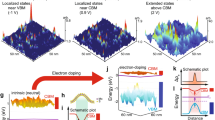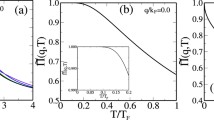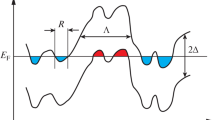Abstract
We present the results of consistent theoretical analysis of various factors that may lead to influence of temperature and external magnetic field on disorder in semiconductor structures. Main attention is paid to quantum well (QW) structures in which only QWs or both QW and barriers are doped (the doping level is assumed to be close to the value corresponding to the metal–insulator transition). The above factors include (i) ionization of localized states to the region of delocalized states above the mobility edge, which is presumed to exist in the impurity band; (ii) the coexistence in the upper and lower Hubbard bands (upon doping of QWs as well as barriers); in this case, in particular, the external magnetic field determines the relative contribution of the upper Hubbard band due to spin correlations at doubly filled sites; and (iii) the contribution of the exchange interaction at pairs of sites, in which the external magnetic field can affect the relation between ferromagnetic and antiferromagnetic configurations. All these factors, which affect the structure and degree of disorder, lead to specific features in the temperature dependence of resistivity and determine specific features of the magnetoresistance. Our conclusions are compared with available experimental data.
Similar content being viewed by others
References
S. D. Das Sarma and E. H. Hwang, Phys. Rev. Lett. 83, 164 (1999).
S. D. Das Sarma and E. H. Hwang, Phys. Rev. B 61, R7838 (2000).
B. I. Altshuler and D. L. Maslov, Phys. Rev. Lett. 82, 145 (1999)
B. L. Altshuler, D. L. Maslov, and V. M. Pudalov, Phys. Status Solidi B 219, 193 (2000).
V. M. Pudalov, G. Brunthaler, A. Prinz, and G. Bauer, cond-mat/0103087.
V. I. Kozub and N. V. Agrinskaya, Phys. Rev. B 64, 245103 (2001).
N. V. Agrinskaya, V. A. Beresovetz, and V. I. Kozub, Solid State Commun. 225, 5660 (2016).
N. V. Agrinskaya, V. I. Kozub, D. V. Shamshur, and A. V. Shumilin, Solid State Commun. 149, 576 (2009).
N. V. Agrinskaya, V. I. Kozub, D. V. Shamshur, A. V. Shumilin, and Y. M. Galperin, J. Phys.: Condens. Matter 22, 405301 (2010).
D. M. Larsen, Phys. Rev. B 47, 16333 (1993).
Author information
Authors and Affiliations
Corresponding author
Additional information
Original Russian Text © N.V. Agrinskaya, V.I. Kozub, 2017, published in Zhurnal Eksperimental’noi i Teoreticheskoi Fiziki, 2017, Vol. 151, No. 2, pp. 364–371.
Rights and permissions
About this article
Cite this article
Agrinskaya, N.V., Kozub, V.I. Effect of temperature and magnetic field on disorder in semiconductor structures. J. Exp. Theor. Phys. 124, 311–317 (2017). https://doi.org/10.1134/S1063776117010095
Received:
Published:
Issue Date:
DOI: https://doi.org/10.1134/S1063776117010095




